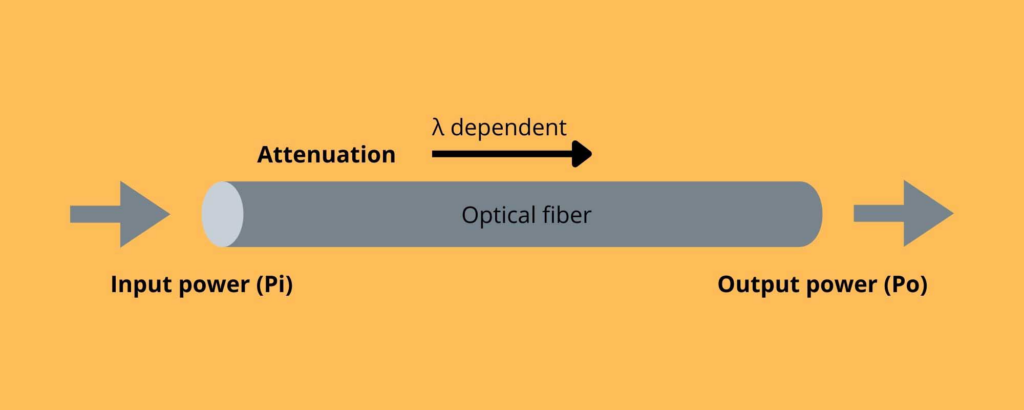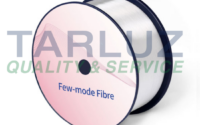What are the characteristic parameters of optical fibers?
Optical fiber parameters can be categorized into three main types: geometric, optical, and transmission characteristics, including:Attenuation (Loss Coefficient)、Dispersion and others.

Attenuation (Loss Coefficient)
Attenuation is one of the most critical parameters for both multimode (MMF) and single-mode fibers (SMF), significantly influencing the maximum transmission distance.
Definition & Formula
Attenuation coefficient (α) measures power loss per kilometer (dB/km):
α=10/L * lg (pi/po) (dB/km)
Pi: Input power (W)
Po: Output power (W)
L: Fiber transmission distance (km)
Example: If α = 3 dB/km, after 1 km, power reduces to half (10^0.3≈2).
Modern SMF Performance
Low-loss SMF: ≤ 0.18 dB/km (e.g., Corning® SMF-28® Ultra).
System Example:
EDFA output: +5 dBm
Receiver sensitivity: -28 dBm
Max theoretical distance: 33 dB
distance (Max theoretical distance/Attenuation coefficient):
33/0.18 dB/km≈183 km (practical distance is shorter due to aging margin).
Causes of Attenuation
Absorption Loss
Impurity absorption (e.g., OH⁻ ions, metal ions).
Intrinsic absorption (SiO₂ molecular vibrations).
Scattering Loss
Rayleigh scattering (linear).
Nonlinear scattering (e.g., Brillouin, Raman).
Structural Imperfections
Microbending, macrobending losses.
Key Mitigation: Ultra-pure silica (impurities < 1 ppb).

Dispersion
Dispersion broadens optical pulses, limiting bandwidth and transmission distance.
Types of Dispersion
Modal Dispersion (MMF only):
Caused by multiple propagation paths (modes) with different speeds.
Dominates in MMF (e.g., OM3: ~1 GHz·km bandwidth).
Material Dispersion:
Wavelength-dependent refractive index of SiO₂.
Waveguide Dispersion:
Due to fiber core/cladding geometry.
Dispersion Coefficient D(λ)
Definition: Pulse broadening per km per nm spectral width (ps/nm·km).
Formula:
Δτ=D(λ)⋅L⋅δλ
: Pulse broadening.
L: Fiber transmission distance
: Laser spectral width.
ITU-T Fiber Standards
| Fiber Type | Zero-Dispersion λ | Application |
|---|---|---|
| G.652 | 1310 nm | Standard SMF (needs dispersion compensation at 1550 nm for 10G+). |
| G.653 | 1550 nm | 10G SMF (unsuitable for DWDM due to FWM). |
| G.655 | ~1550 nm (low) | Optimized for DWDM/SDH. |
Key Rule: Zero dispersion → High nonlinearities (e.g., four-wave mixing (FWM) in DWDM).
Bandwidth (Bc), NA, MFD, and Cutoff Wavelength (λc)
Bandwidth (Bc)
Definition: Frequency at which output power drops to 50% (3 dB bandwidth).
Relation to Dispersion:
Bc≈0.44Δτ
SMF vs. MMF:
SMF: > 25 GHz·km (dominated by chromatic dispersion).
MMF: < 1 GHz·km (modal dispersion-limited).
Numerical Aperture (NA)
Definition: Light-gathering ability (NA=sinθc, where θc is acceptance angle).
Trade-off: Higher NA → More light capture but worse modal dispersion.
Standard Range: 0.18–0.24 (ITU-T recommendation).
Mode Field Diameter (MFD)
Definition: Effective diameter of light propagation in SMF (~9–10 µm at 1550 nm).
Approximation: Close to core diameter (SMF: ~8–10 µm).
Cutoff Wavelength ()
Definition: Minimum wavelength for single-mode operation (e.g., G.652: λc≤1260 nm).
Ready to explore the world of optical fibers? Tarluz for personalized advice and support!
Related Article:
Patch Cords to Connect Inband Equipment to Structured Fiber Cabling


